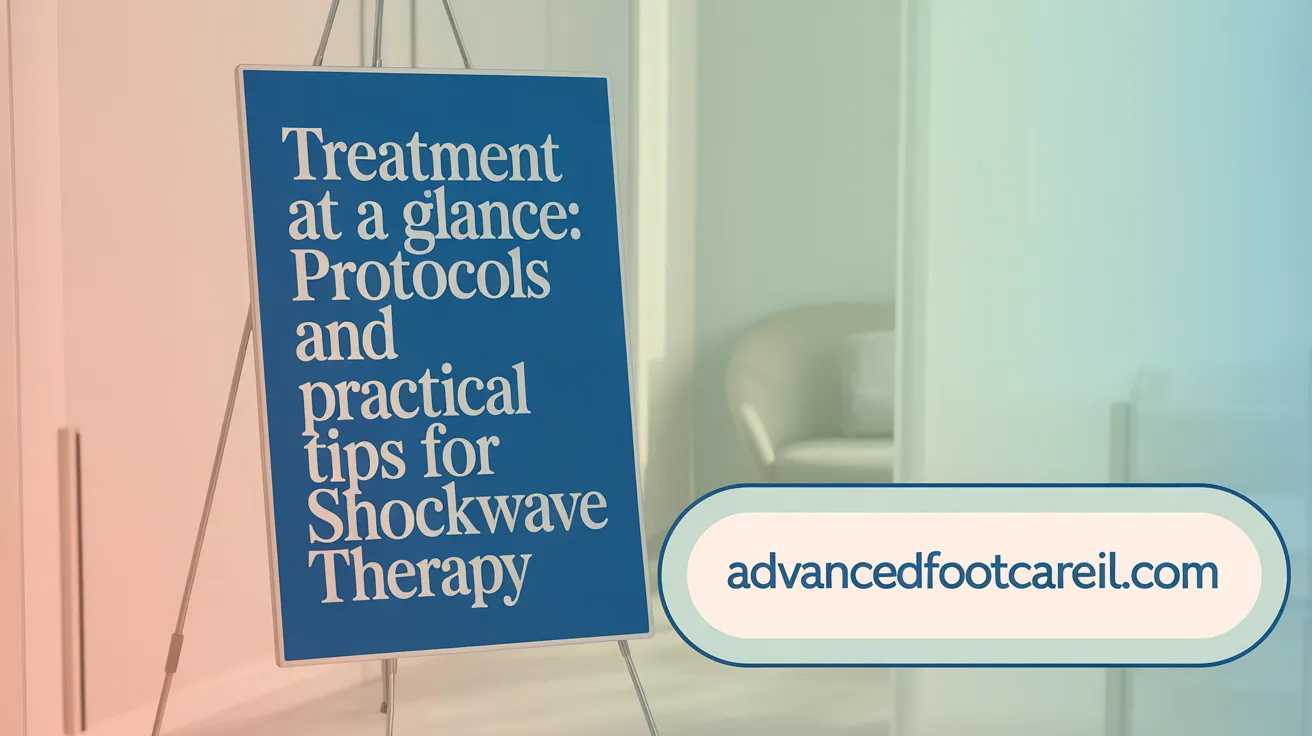Understanding New Horizons in Foot Pain Management
Chronic foot and ankle pain can drastically affect quality of life, limiting mobility and daily activities. In recent years, shockwave therapy has emerged as a cutting-edge, non-invasive treatment option offering relief for a range of debilitating foot conditions. This article explores how shockwave therapy works, its clinical applications, benefits, and how it compares with other pain relief modalities to help patients and practitioners optimize foot and ankle care.
What Is Shockwave Therapy and How Does It Treat Foot Pain?

What is shockwave therapy and how is it used to treat foot and ankle pain?
Shockwave therapy, also known as Extracorporeal Shockwave Therapy (ESWT), is a non-invasive treatment that employs high-energy sound waves to aid in healing damaged tissues. It is widely used in treating foot and ankle conditions such as plantar fasciitis, Achilles tendinitis, heel spurs, and stress fractures. The therapy stimulates biological responses that promote tissue repair, reduce pain, and decrease inflammation.
There are different types of shockwave therapy suited for various conditions. Focused ESWT (F-SWT) directs narrow, concentrated waves at specific tissue depths, initially used for kidney stones but now adapted for musculoskeletal issues. Radial ESWT (R-SWT), on the other hand, transmits diffuse, radial waves to a depth of about 4 to 5 centimeters, ideal for broader treatment areas like plantar fasciitis.
Another form is Electromagnetic Pressure Acoustic Therapy (EPAT), which delivers pressure waves via a handheld device, stimulating blood flow and natural healing in the affected regions.
How does shockwave therapy work at the biological level?
The therapy generates acoustic pressure waves that induce microtrauma in injured tissues. This microtrauma triggers healing by increasing blood circulation, promoting collagen production, stimulating the release of growth factors, and breaking down calcifications or scar tissue. These biological responses facilitate faster tissue regeneration and pain relief.
By enhancing cell proliferation and neovascularization, shockwave therapy accelerates the body's healing processes, making it especially beneficial for chronic conditions resistant to conservative treatments.
What foot and ankle conditions can be treated?
Shockwave therapy effectively targets a variety of foot and ankle conditions, including:
| Condition | Description | Response | Additional Details |
|---|---|---|---|
| Plantar fasciitis | Inflammation of the plantar fascia causing heel pain | Pain reduction and improved function | Often treated with 3-4 sessions, visible benefits after initial treatments |
| Achilles tendinitis | Tendon inflammation at the back of the heel | Decreased pain and tendon healing | Suitable for athletes; can prevent surgery |
| Heel spurs | Calcified deposits causing heel pain | Relief of discomfort | Usually part of broader treatment plans |
| Shin splints | Pain along the shinbone | Pain alleviation | Often targeted with radial shockwave |
| Stress fractures | Small breaks in bone tissue | Accelerated healing | Higher energy levels used |
Other applications include bursitis, neuromas, tendinopathies, and post-surgical pain management.
What makes shockwave therapy a non-invasive outpatient treatment?
Shockwave therapy is performed in-office without the need for anesthesia or surgical incisions. It involves no drugs or invasive procedures, making it a safe option for many patients. The treatment sessions are quick, typically lasting between 5 to 15 minutes, and do not require hospitalization.
Patients can usually bear weight immediately afterward and go about their daily routines. The minimal downtime and low risk of complications make it an attractive alternative to surgery.
What does the treatment process look like?
A typical series involves 3 to 4 sessions spaced weekly. Each session consists of applying the device to the affected area, with treatment times ranging from 5 to 15 minutes depending on the condition and device type. Patients often notice relief after as few as 3 treatments, with continued improvements over several weeks.
Some patients may experience mild discomfort or skin redness temporarily after sessions, but serious side effects are rare. If the treatment proves ineffective, it can be discontinued without adverse effects.
Overall, shockwave therapy offers a safe, effective, and evidence-supported approach to managing persistent foot and ankle pain, helping many avoid more invasive procedures and facilitating quicker recoveries.
Medical Conditions Amenable to Shockwave Therapy for Foot and Musculoskeletal Pain
 Shockwave therapy has become a versatile treatment option for various foot and musculoskeletal issues. Conditions such as plantar fasciitis, Achilles tendinopathy, heel spurs, and ankle tendinitis are commonly treated with this non-invasive procedure. It is also effective for stress fractures and ligament sprains, particularly when conventional therapies have failed or the injury has persisted for more than six weeks.
Shockwave therapy has become a versatile treatment option for various foot and musculoskeletal issues. Conditions such as plantar fasciitis, Achilles tendinopathy, heel spurs, and ankle tendinitis are commonly treated with this non-invasive procedure. It is also effective for stress fractures and ligament sprains, particularly when conventional therapies have failed or the injury has persisted for more than six weeks.
This therapy works by stimulating natural healing processes. It promotes blood flow, encourages tissue regeneration, increases collagen production, and breaks down calcified tissues or scar tissue that impede recovery. The treatment can be used for both acute injuries and chronic soft tissue problems.
Beyond foot conditions, shockwave therapy has applications across tendinopathies and bone injuries. It is useful in managing shoulder tendinitis, lateral epicondylosis (tennis elbow), greater trochanteric pain syndrome, hamstring tendinopathy, patellar tendinopathy, medial tibial stress syndrome, and stress fractures. Its role extends to conditions like knee osteoarthritis, non-healing fractures, and nerve-related issues such as spasticity.
Patients benefit from this approach because it offers a pain relief option that is non-invasive, requires no anesthesia, and involves minimal discomfort. With proven results supported by numerous studies, shockwave therapy can significantly reduce inflammation, promote healing, and often eliminate or reduce the need for surgical intervention.
In summary, shockwave therapy provides an effective treatment for a broad range of foot and musculoskeletal conditions. Its ability to stimulate natural tissue healing makes it a valuable option for patients dealing with persistent pain and injury, offering a pathway to recovery without the risks associated with surgery.
Scientific Foundations: How Shockwave Therapy Works to Relieve Pain

How does shockwave therapy work at a scientific level to relieve foot pain?
Extracorporeal Shockwave Therapy (ESWT) employs high-energy sound waves to penetrate tissues and stimulate biological responses at a cellular level. These mechanical stimuli trigger what's known as mechanotransduction pathways, where physical forces are converted into biochemical signals within cells.
When shockwaves are applied, they induce cellular responses that promote healing. They stimulate the release of growth factors like vascular endothelial growth factor (VEGF), transforming growth factor-beta 1 (TGF-β1), and insulin-like growth factor 1 (IGF-1). These molecules are crucial for the formation of new blood vessels (neovascularization), tissue repair, and overall regeneration.
In addition to fostering new blood flow, ESWT enhances collagen synthesis, which is vital for repairing tendons and fascia. The therapy also influences cell membrane ion channels and increases calcium mobilization inside cells. This activity boosts cellular metabolism and accelerates the production of proteins necessary for tissue repair.
The acoustic waves further modulate immune responses by guiding macrophages—immune cells responsible for inflammation—toward an anti-inflammatory phenotype. This reduces persistent inflammation that often contributes to chronic foot pain.
Electrophysiologically, the energy delivered by shockwaves can disrupt pain signaling pathways, which diminishes the sensation of pain. Stimulating the body's natural healing processes while reducing inflammation makes ESWT an effective non-invasive treatment for foot and ankle issues.
Overall, this complex interplay of cellular and molecular mechanisms helps restore tissue integrity, improves blood circulation, and alleviates discomfort, providing lasting pain relief.
Treatment Protocols and Practical Application of Shockwave Therapy
 Shockwave therapy (ESWT) usually involves a series of outpatient treatments that are designed to maximize healing while minimizing discomfort. Typically, a patient undergoes 3 to 5 sessions, spaced about one week apart. Each session lasts approximately 15 to 20 minutes, during which the appropriate device is applied to the affected area.
Shockwave therapy (ESWT) usually involves a series of outpatient treatments that are designed to maximize healing while minimizing discomfort. Typically, a patient undergoes 3 to 5 sessions, spaced about one week apart. Each session lasts approximately 15 to 20 minutes, during which the appropriate device is applied to the affected area.
There are two main types of shockwave delivery: focused shockwave therapy (F-SWT) and radial shockwave therapy (R-SWT). F-SWT generates high-energy, converging pressure waves that can target deep tissue with precision. It originated in lithotripsy to break kidney stones and is used for deeper or specific musculoskeletal issues.
In contrast, R-SWT transmits acoustic waves in a more diffuse, radial pattern, with maximal pressure exerted near the applicator and gradually decreasing with depth. It typically reaches tissues at depths of around 4 to 5 cm, making it suitable for more superficial conditions.
The therapy employs varying energy levels, categorized as low, medium, or high energy flux density (EFD). High EFD is often used for bone or calcification problems, while lower EFD is preferred for tendinopathies to reduce risk and discomfort.
Patients generally receive between 2000 to 4000 pulses per session, depending on the condition and device settings. Treatment protocols adapt these parameters to optimize outcomes. During sessions, a coupling gel ensures good contact, and clinicians target the site of pain or pathology, often guided by imaging.
Adequate training for practitioners and strict adherence to safety protocols are essential. Proper patient selection, including ruling out contraindications like pregnancy or active infections, further enhances safety.
In summary, shockwave therapy involves carefully calibrated sessions using either focused or radial devices, with adjustments based on the specific condition, aiming for maximum benefit with minimal side effects.
Comparing Shockwave Therapy with Other Foot Pain Relief Options and Candidate Suitability

How does shockwave therapy compare to other pain relief options for foot conditions?
Shockwave therapy (ESWT) offers a non-invasive, effective alternative for treating foot ailments like plantar fasciitis. It often produces quicker pain relief with minimal side effects compared to more invasive options. Unlike medications or steroid injections, ESWT doesn’t involve drugs or needles, reducing risk and downtime. Surgery, while sometimes necessary in severe cases, involves longer recovery and higher complication risks. ESWT balances effectiveness with safety, making it ideal for those seeking to avoid surgery. While orthotics or platelet-rich plasma (PRP) might sometimes provide longer-term benefits, ESWT's rapid action and safety profile make it a popular choice for managing ongoing foot pain.
Who are suitable candidates for shockwave therapy in managing foot-related pain?
Candidates typically include individuals suffering from chronic foot conditions, such as plantar fasciitis or tendinopathy, that have not responded to conventional treatments like physiotherapy, orthotics, or injections. Patients should have a confirmed diagnosis via imaging and be in overall good health. It’s crucial that they do not have contraindications such as infections, bleeding disorders, or metabolic bone diseases. Pregnant women, those with implanted medical devices like pacemakers, or individuals on blood thinners or steroids recently should avoid the therapy. Proper screening ensures that shockwave therapy is both safe and effective for foot pain management.
Comparison table of foot pain treatment options, advantages, limitations, and suitability
| Treatment Option | Invasiveness | Recovery Time | Effectiveness | Suitability | Limitations | Cost & Insurance |
|---|---|---|---|---|---|---|
| Medications & Injections | Non-invasive | Variable | Short-term relief | Mild to moderate pain | Side effects, not curative | Often covered, variable |
| Surgery | Invasive | Long, recovery period | Potentially curative | Surgical risks, scarring | Usually expensive, may require insurance pre-authorization | |
| ESWT (Shockwave) | Non-invasive | Immediate to short-term | High success rate, especially for soft tissue healing | Chronic conditions, failed conservative care | Usually out-of-pocket, possible FSA/HSA use | |
| Orthotics & PRP | Non-invasive | Long-term | Variable, depending on case | Mild to moderate cases | May need ongoing use, variable results | Costs vary, often not covered |
This overview helps clarify the options available for foot pain relief, emphasizing shockwave therapy’s role as a safe, effective, and minimally invasive alternative suitable for many patients.
Harnessing Shockwave Therapy for Advanced Foot Pain Relief
Shockwave therapy stands out as a revolutionary approach in the management of foot and ankle pain, combining scientific precision with practical benefits. By harnessing focused acoustic energy to stimulate natural healing mechanisms, it offers significant pain relief, improved function, and tissue regeneration without surgery or drugs. It is especially valuable for patients with chronic, stubborn foot conditions who have not found success with conventional treatments. Understanding its mechanisms, protocols, and appropriate patient selection is crucial for maximizing outcomes. As research continues to deepen and technologies evolve, shockwave therapy is poised to become a cornerstone of advanced, non-invasive foot care — transforming the lives of those burdened by foot pain.
References
- Relieve Foot Pain with Extracorporeal Shockwave Therapy
- What Are Benefits of Shockwave Therapy for Foot Pain ...
- The evolving use of extracorporeal shock wave therapy ...
- Shockwave Therapy For Heel Pain & Tendonitis Relief
- Radial Shockwave Therapy: Advanced Foot Pain Relief
- What Is EPAT Shockwave Therapy for Foot Pain
- Best practices for extracorporeal shockwave therapy in ...
- The Role of Shockwave Therapy in Foot Pain Management ...
- Combining Shockwave Therapy with Minimally Invasive ...
- Mayo Clinic Q and A: Shockwave therapy may help relieve ...
